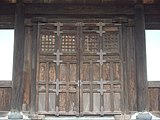Zenshūyō

Zenshūyō (禅宗様, "Zen style") is a
History

At the end of the 12th century, more or less while in Nara
A little later,
After arriving in Japan the style started to evolve in response to local conditions and tastes. Among its innovations is the roof, covered in wood shingles rather than tiles, as in China. Also, Zen temple buildings have a so-called "hidden roof" structure, consisting in two roofs, the true one and a second underneath it. The second, false roof hides the first, making it possible to obtain sloping roofs and shallow eaves.[3] The invention of the hidden roof in the 10th century allowed the inclination of the roof's underside to be completely different from that of the exterior, thus making Japanese temples feel very different from their Chinese counterparts.
Characteristics

The Zen sect was very successful, and therefore often imitated. Many of its innovations were therefore widely adopted by other Buddhist schools. Zenshūyō's characteristics are decorative pent roofs (mokoshi) and pronouncedly curved main roofs, cusped windows (katōmado), earthen floors and paneled doors.[4][5][6] Wood structures are relatively light, design light and orderly.[7] All buildings are erected on stone podia and have either stone or earthen floors.
Other important characteristics are:
- More or less fixed garan composition and layout
Zen's discipline is strict and its rules many and complex. As a consequence, the Zen
- Use of penetrating tie beams
During the Heian period temples were built using only non-penetrating tie beams (nageshi (長押)) made to fit around columns and pillars, then nailed. The daibutsuyō style and the zenshūyō style replaced them with penetrating tie-beams (nuki (長押)), which actually pierced the column, and were therefore much more effective against earthquakes.[8][9] The nageshi was however retained as a purely decorative element.[10]
- Tokyōbetween posts
While other styles put roof-supporting brackets only above columns, Zen temples have them also between columns (see photo above).[2]
- Tōrihijiki
Each bracket step has its own tōrihijiki or tōshihijiki (通り肘木), a long horizontal beam parallel to the wall and inserted into the bracket step.[11][12] (See photo in the gallery.) It strengthens the structure while at the same time supporting the roof rafters.
- Odaruki
A tokyō's third step is usually supported by a so-called tail rafter (尾垂木, odaruki), a cantilever set between the second and the third step (see illustration in the gallery). The name refers to its typical shape, similar to a tail protruding from the bracket.[13]
- Kibana
Another Zenshūyō feature is the kobushibana (拳鼻, lit. fist nose) or kibana (木鼻, lit. wooden nose), a nose-like decoration with a spiraling motif carved on a rafter after the last protruding bracket. (See photo in the gallery.)[3]
- Fan-shaped roof rafters
Roof rafters radiate outwards from a single central point.[2]
- Paneled doors
Doors called sankarado (桟唐戸) are made of separate panels and do not slide, but are fixed to the tie beams by heavy hinges called waraza (藁座).
- Sōmon and sanmon
The entrance to a Zen temple is straddled by two symbolic gates, the sōmon and the more important sanmon.[2]
Typical of the style is also the main hall (
- Cusped windows
Zen temples have typical bell-shaped windows called katōmado (火灯窓, fire light window). Originally the two sides were vertical, but they acquired a slant later on. Their use is now widespread, and they can be found even at Shinto shrines and castles.[15]
- No pagoda
Because of the decline in the use of pagodas, like that of other younger schools the Zen garan usually does not have a
Gallery
-
Zen sanmon (Tōfuku-ji)
-
Katōmado (Nanzen-ji)
-
Intercolumnar tokyō, each of the three steps having a tōrihijiki (Daitoku-ji)
-
Odaruki (Engaku-ji)
-
Kobushibana/kibana (Kōmyo-ji). Click to enlarge and display captions
-
Sanmon (Nanzen-ji)
-
Linear layout (Kenchō-ji)
-
Sankarado (Kennin-ji)
Examples
-
Zenpuku-in's shaka-dō, built in 1327
-
Anraku-ji'spagoda, built in the 14th century
-
Engaku-ji's shariden
See also
Notes
- ^ Parent, Mary Neighbour. "Zenshuuyou". Japanese Architecture and Art Net Users System. Retrieved 2011-04-06.
- ^ a b c d e Nishi & Hozumi (1996), pp. 26–27.
- ^ a b c d e Nishi & Hozumi (1996), pp. 22–23.
- ^ Fletcher & Cruickshank (1996), p. 737.
- ^ Nishi & Hozumi (1996), p. 20.
- ^ Fletcher & Cruickshank (1996), p. 738.
- ^ Hamashima (1999), pp. 241–243.
- ^ Hamashima (1999), p. 160.
- ^ Nishi & Hozumi (1996), pp. 24–25.
- ^ Parent, Mary Neighbour. "Nageshi". Japanese Architecture and Art Net Users System. Retrieved 2011-04-06.
- ^ Parent, Mary Neighbour. "Tooshihijiki". Japanese Architecture and Art Net Users System. Retrieved 2011-04-14.
- ^ Hamashima (1999), p. [page needed].
- ^ Parent, Mary Neighbour. "Odaruki". Japanese Architecture and Art Net Users System. Retrieved 2011-04-13.
- ^ Parent, Mary Neighbour. "Butsuden". Japanese Architecture and Art Net Users System. Retrieved 2011-04-17.
- ^ Parent, Mary Neighbour. "Katoumado". Japanese Architecture and Art Net Users System. Retrieved 2011-04-13.
Bibliography
- ISBN 0-7506-2267-9. Retrieved 2009-11-11.
- Hamashima, Masashi (1999). Jisha Kenchiku no Kanshō Kiso Chishiki (in Japanese). Tokyo: Shibundō.
- Nishi, Kazuo; Hozumi, Kazuo (1996) [1983]. What is Japanese architecture? (illustrated ed.). Kodansha International. ISBN 4-7700-1992-0. Retrieved 2009-11-11.












